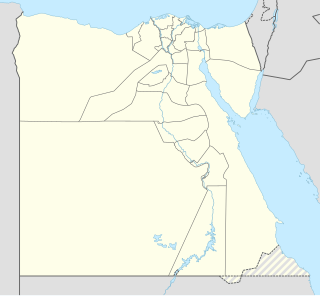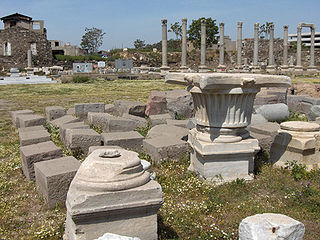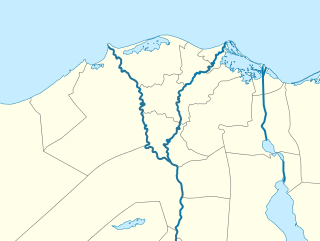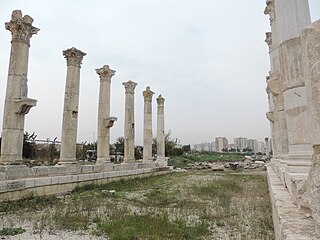Related Research Articles

Mendes, the Greek name of the ancient Egyptian city of Djedet, also known in ancient Egypt as Per-Banebdjedet and Anpet, is known today as Tell El-Ruba.

Menkaure, was an ancient Egyptian king (pharaoh) of the fourth dynasty during the Old Kingdom, who is well known under his Hellenized names Mykerinos and Menkheres. According to Manetho, he was the throne successor of king Bikheris, but according to archaeological evidence he rather was the successor of king Khafre. Africanus reports as rulers of the fourth dynasty Sôris, Suphis I, Suphis II, Mencherês, Ratoisês, Bicheris, Sebercherês, and Thamphthis in this order. Menkaure became famous for his tomb, the Pyramid of Menkaure, at Giza and his beautiful statue triads, showing the king together with his wives Rekhetre and Khamerernebty and with various deities.

Bubastis, also known in Arabic as Tell-Basta or in Egyptian as Per-Bast, was an ancient Egyptian city. Bubastis is often identified with the biblical Pi-Beseth. It was the capital of its own nome, located along the River Nile in the Delta region of Lower Egypt, and notable as a center of worship for the feline goddess Bastet, and therefore the principal depository in Egypt of mummies of cats.

Leontopolis was an ancient Egyptian city located in the Nile Delta, Lower Egypt. It served as a provincial capital and Metropolitan Archbishopric, which remains a Latin Catholic titular see. The archaeological site and settlement are known today as Kafr Al Muqdam.
A nome was a territorial division in ancient Egypt.

Aeolis, or Aeolia, was an area that comprised the west and northwestern region of Asia Minor, mostly along the coast, and also several offshore islands, where the Aeolian Greek city-states were located. Aeolis incorporated the southern parts of Mysia, and is bounded by it to the north, Ionia to the south, and Lydia to the east.

Samannud is a city (markaz) located in Gharbia Governorate, Egypt. Known in classical antiquity as Sebennytos, Samannud is a historic city that has been inhabited since the Ancient Egyptian period. As of 2019, the population of the markaz of Samannud was estimated to be 410,388, with 83,417 people living in urban areas and 326,971 in rural areas.

Soli, often rendered Soli/Pompeiopolis, was an ancient city and port in Cilicia, 11 km west of Mersin in present-day Turkey.

Alabanda or Antiochia of the Chrysaorians was a city of ancient Caria, Anatolia, the site of which is near Doğanyurt, Çine, Aydın Province, Turkey.
Anthylla is an ancient city of Lower Egypt, on the Canopus branch of the Nile river. Herodotus and Athenaeus report that it provided furnishings for the queen of Egypt. It is sometimes thought to be the ancient city of Gynaecopolis.
Arsinoe was an ancient city in northwestern Cyprus built on top of the older city, Marion ; some ancient writers conflate the two cities.
A bustuarius was a kind of gladiator in Ancient Rome, who fought about the funeral pyre of the deceased at a Roman funeral.
Hermopolis, also known as Hermopolis Parva, was the Greek name for two cities in ancient Egypt. One was the capital of Tehut, the 15th nome of Lower Egypt, situated a little below Thmuis. The site is currently at Tell al-Naqus near Baqliya. The ancient Egyptian names of this city were Ba'h and Weprehwy.

Busiris was an ancient city in Lower Egypt, located at the present-day Abu Sir Bana.

The Porta Esquilina was a gate in the Servian Wall, of which the Arch of Gallienus is extant today. Tradition dates it back to the 6th century BC, when the Servian Wall was said to have been built by the Roman king Servius Tullius. However modern scholarship and evidence from archaeology indicate a date in the fourth century BC. The archway of the gate was rededicated in 262 as the Arch of Gallienus.

Middle Egypt is the section of land between Lower Egypt and Upper Egypt, stretching upstream from Asyut in the south to Memphis in the north. At the time, Ancient Egypt was divided into Lower and Upper Egypt, though Middle Egypt was technically a subdivision of Upper Egypt. It was not until the 19th century that archaeologists felt the need to divide Upper Egypt in two. As a result, they coined the term "Middle Egypt" for the stretch of river between Cairo and the Qena Bend. It was also associated with a region termed "Heptanomis", generally as the district which separates the Thebaïd from the Delta.

Damanhur is a city in Lower Egypt, and the capital of the Beheira Governorate. It is located 160 km (99 mi) northwest of Cairo, and 70 km (43 mi) E.S.E. of Alexandria, in the middle of the western Nile Delta.
Erymna or Orymna was a town in ancient Pamphylia or Lycia. The form "Orymna" is that given in the Synecdemus and the Notitiae Episcopatuum. and in the ecumenical councils, but inscriptions found on the site show that the inhabitants used the form with "E". Stephanus of Byzantium stated that the form used in the Lyciaca of Alexander Polyhistor was Erymnae. The modern name of the site is Ormana, reflecting the ancient name.

Setae or Setai, or Settae or Settai (Σέτται), or Saettae or Saittai or Saittae (Σαίτται) was a town of ancient Lydia, located at Sidas Kaleh in Modern Turkey. The ruins of that town consist of a stadium, tombs and ruins of several temples. The town is not mentioned by any of the earlier writers, but appears in Ptolemy and Hierocles.
Rheomithres was a Persian noble. He was father of several children, including Phrasaortes whom Alexander the Great appointed satrap of Persis in 330 BC. He joined in the Great Satraps' Revolt of the western Persian provinces from Artaxerxes II, in 362 BC, and was employed by his confederates to go to Tachos, pharaoh of Egypt, for aid. He came back with 500 talents and 50 warships and he is supposed to have left his wife and his children to Tachos as a guarantee for his assistance. Nevertheless, Rheomithres betrayed the rebels and he invited a number of them in a meeting. On their arrival, he arrested them, and despatched them in chains to Artaxerxes to receive the bounties, thus making his own peace at court. Rheomithres took part in the battle of the Granicus, in 334 BC, where he was in command of a body of 2,000 cavalry on the right wing, between 1,000 Medes and 2,000 Bactrians. He survived the battle and the next year he joined Darius at the battle of Issus where he lost his life.
References
- 1 2 "Shire 08 Nomes Lower Egypt-:- Flash cards by cueFlash". cueflash.com. Retrieved 2018-02-26.
- ↑ "E. R. Bevan: The House of Ptolemy • Chap. V § 2". Penelope.uchicago.edu. Retrieved 2012-11-10.
- 1 2 "Gynaecopolis". Dictionary of Greek and Roman Geography. Perseus.tufts.edu. Retrieved 2012-11-10.
- 1 2 "Anthylla". Dictionary of Greek and Roman Geography. Perseus.tufts.edu. Retrieved 2012-11-10.
Coordinates: 30°47′40″N30°36′01″E / 30.79444°N 30.60028°E
| | This article about Egyptology or subjects relating to Ancient Egypt is a stub. You can help Wikipedia by expanding it. |